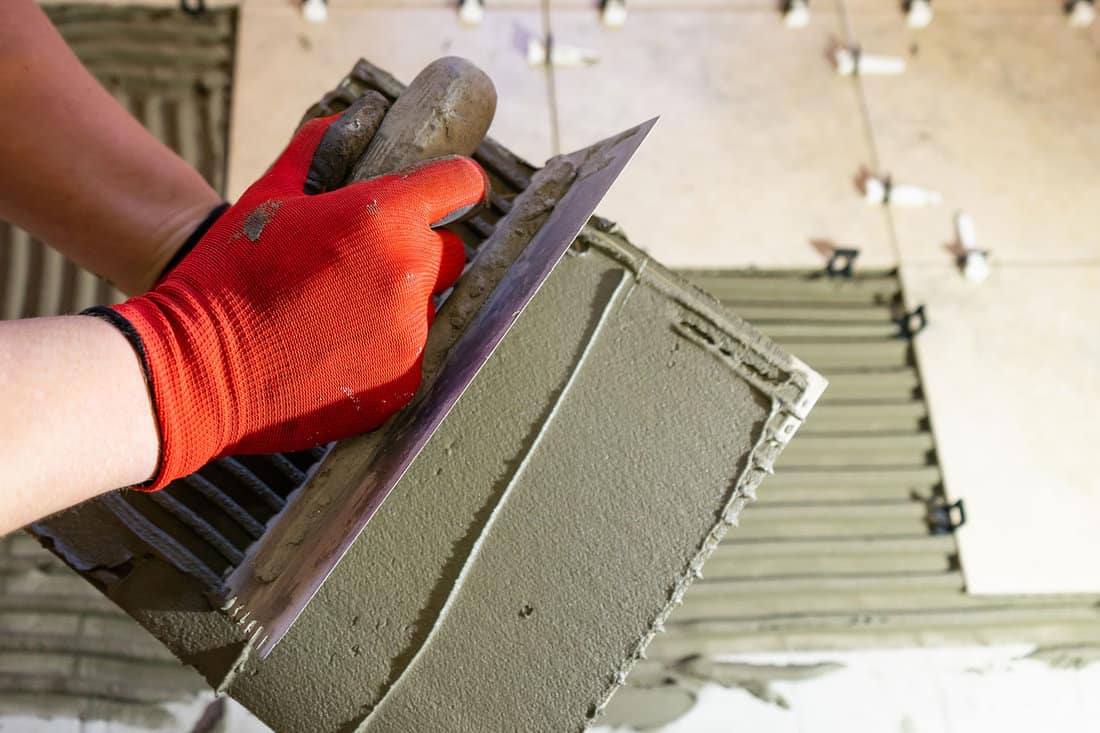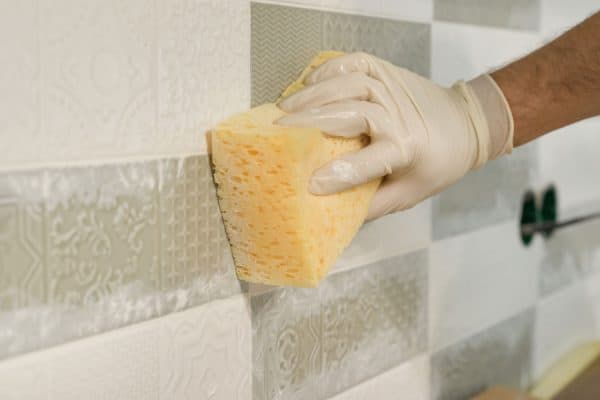Thinset is a type of mortar that is commonly used for tiling. It is a mixture of cement, sand, and a moisture-retaining agent.

Thinset is known for its strong bonding properties and is ideal for tiling over various surfaces, including concrete, wood, and even existing tiles.
However, when it comes to tiling over Formica, many people wonder whether thinset will stick to the surface.
The answer is yes, thinset will stick to Formica.
However, it is important to note that the Formica surface must be properly prepared before tiling and that better bonding alternatives exist.
Compatibility of Thinset and Formica
Thinset is a cement-based adhesive that is commonly used to attach tiles to various surfaces.
Formica, on the other hand, is a laminate material that is often used for countertops and other surfaces.
This section will explore the compatibility of thinset and Formica.
Chemical Composition
Thinset is made up of Portland cement, sand, and additives.
The Portland cement is the primary binding agent, while the sand provides structure and stability. The additives are used to improve the adhesive properties of the thinset.
Formica, on the other hand, is made up of layers of paper or fabric that have been impregnated with resin and then bonded together under heat and pressure.
The top is a decorative layer printed with a pattern or color.
The chemical composition of thinset and Formica is quite different, meaning they do not naturally bond well together.
However, there are ways to improve the bond between the two materials.
Surface Texture
If the surface is too smooth, the thinset may not be able to adhere properly. This is because the thinset needs something to grab onto to create a strong bond.
To improve the surface texture of the Formica, it may be necessary to sand or etch the surface.
This can create a rougher surface that the thinset can grip onto. It is important to note that the surface of the Formica should not be so rough that it damages the decorative layer on top.
It is also important to clean the surface of the Formica thoroughly before applying the thinset to ensure that no dirt or debris could interfere with the bond.
Pros and Cons of Using Thinset on Formica
Regarding tiling over Formica, thinset is a popular choice for many DIY enthusiasts and professionals.
However, some pros and cons to using thinset should be considered before starting the project.
Pros
Strong bond
Thinset is an adhesive that creates a strong bond between the tile and the Formica surface. This ensures the tiles stay in place and do not come loose over time.
Can fill gaps
Thinset can fill gaps between the tiles and the Formica surface. This helps create a smooth, level surface for the tiles to be installed.
Durable
Thinset is a durable adhesive that can withstand the weight and pressure of heavy tiles.
It is also resistant to water and moisture, which makes it ideal for use in bathrooms and kitchens.
Also read: Best Type Of Tile For Shower Walls
Cons
Slow drying time
Thinset takes longer to dry than other types of adhesives, which can slow down the tiling process.
It is important to allow enough time for the thinset to dry before grouting the tiles.
Messy application
Thinset can be messy to apply and difficult to clean up if it gets on surfaces other than the tiles.
Take precautions to protect the surrounding areas when applying thinset.
Best Alternatives
Epoxy is the best adhesive to use when bonding tile to Formica or other plastic surfaces. It provides a strong bond that is resistant to water and heat.
However, it is important to note that not all epoxy adhesives are suitable for use with tile.
Be sure to choose an epoxy adhesive that is specifically designed for use with tile.
Another option is to remove the Formica surface and replace it with a suitable substrate, such as a cement backer board.
This will provide a solid surface for the tile to bond to, ensuring a long-lasting and durable installation.
FAQ Section: Common Questions About Thinset and Formica
Q: How long should I wait after applying thinset before laying tiles on Formica?
A: After applying thinset to Formica, it's a good idea to wait at least 20 to 30 minutes before laying tiles.
This allows the thinset to become tacky, ensuring a better bond.
However, always check the manufacturer's instructions; the wait time can vary depending on the brand and type of thinset you're using.
Q: Can I paint or seal over tiles laid on Formica?
A: Yes, you can paint or seal tiles that are laid on Formica. If you're painting, make sure to use a primer first, so the paint sticks well to the tile.
When sealing, choosing a sealer designed for tiles is crucial to ensure it offers the protection you need.
Always clean the tiles thoroughly and let them dry before painting or sealing.
Q: What type of thinset is best for Formica surfaces?
A: While thinset can bond to Formica, using a modified thinset with added polymers might provide a better bond.
However, epoxy adhesive is recommended over thinset for Formica surfaces.
Q: Why is it not ideal to use thinset directly on Formica?
A: Formica is a smooth and non-porous surface.
Thinset adheres better to rougher, more porous surfaces, which is why proper surface preparation or using a different adhesive might be recommended.
Q: How do I prepare my Formica surface for tiling?
A: Sanding or etching the Formica can help create a rougher surface for the thinset to grip.
It's essential to clean the surface thoroughly after to remove any dust or debris.
Q: Will tiles on Formica stand up to heavy usage areas, like kitchen countertops?
A: With the right adhesive and proper installation, tiles on Formica can be quite durable.
However, the bond is only as strong as the underlying Formica. If the Formica layer begins to peel or degrade, it can compromise the tiles on top.
Q: Can I use grout with tiles laid on Formica?
A: After tiles are set and the adhesive has cured, you can grout the tiles just as you would on any other surface.
Ensure the spaces between the tiles are clean and free from any adhesive before grouting.
Professional Recommendation
When tiling Formica surfaces, it is always recommended to consult a professional tiler for the best results.
Tiling Formica has risks of bonding failure if not done properly. Professional expertise can help avoid costly mistakes.
The Verdict
Materials like thinset and surfaces such as Formica play pivotal roles in tiling.
While thinset offers a strong bond for many surfaces, its compatibility with Formica can be tricky.
Proper preparation and understanding of both materials are vital for a successful and long-lasting installation.
While DIY projects can be rewarding, tiling requires precision, expertise, and suitable materials.
Consulting with a professional tiler or expert in the field is always smart if you're considering tiling over Formica or any unconventional surface.
They can provide invaluable insights, recommend the best products, and even assist with the project.
So, before you dive in, seek expert advice to ensure your tiling project stands the test of time.
Also read: How To Mix Grout For Bathroom Tile


![The working tiler removes the glued tile from the wall, the technology of professional and highly skilled tile work - How to Remove Mortar From Old Tiles For Reuse [the Ultimate Guide]](https://homedecorbliss.com/wp-content/uploads/2023/08/The-working-tiler-removes-the-glued-tile-from-the-wall-the-technology-of-professional-and-highly-skilled-tile-work-600x400.jpg)
